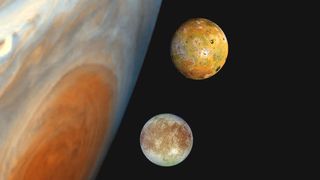Jupiter's volcanic moon Io may spew sulfur to icy neighbor Europa's surface
Sulfur dioxide was found on the backside of Europa thanks to Jupiter's magnetic field.

Researchers have mapped material on the backside of Jupiter's moon Europa, revealing that sulfur detected on its surface likely came from Io, a large and volcanically active Jovian moon.
Using the Hubble Space Telescope, a team led by the Southwest Research Institute (SwRI) observed Europa in ultraviolet wavelengths, filling a gap in the various wavelengths used to observe the icy water world.
This effort produced the first near-global map of sulfur dioxide on Europa. Though this is not the first time this compound has been detected on Europa, the map shows solid-state sulfur dioxide with better coverage and resolution than previous observations. Concentrations of the material also correlate with large-scale darker regions in both the visible and ultraviolet wavelengths.
Related: NASA spacecraft snaps gorgeous new photo of Jupiter's moons Io and Europa
The findings revealed that the sulfur likely erupts out of Io, the solar system's most volcanically active body, and is then ionized and caught up in Jupiter's magnetic field. It is then transported to Europa, where it reacts with the water in the icy moon's frozen crust to form sulfur dioxide.
But there is also the possibility that the compound originates from below the surface of Europa.
"Europa's relatively young surface is primarily composed of water ice, although other materials have been detected across its surface," said Tracy Becker, a planetary scientist at SwRI and lead author of a paper describing the UV observations, said in a statement. "Determining whether these other materials are native to Europa is important for understanding Europa's formation and subsequent evolution."
Get the Space.com Newsletter
Breaking space news, the latest updates on rocket launches, skywatching events and more!
The larger concentrations of sulfur dioxide found on Europa's trailing hemisphere as it orbits Jupiter suggests the sulfur originates from Io.
"Most of the sulfur dioxide is seen on the 'trailing' hemisphere of Europa," Philippa Molyneux, a SwRI scientist and co-author of the paper, said in the statement. "It's likely concentrated there because Jupiter's co-rotating magnetic field traps sulfur particles spewing from Io's volcanoes and slams them against the backside of Europa."
SwRI intends to build on these studies using the Europa Ultraviolet Spectrograph. That instrument will observe Jupiter's fourth-largest moon as a part of NASA's Europa Clipper mission, which is scheduled to launch in 2024 and arrive in the Jupiter system in 2030.
Scientists are almost certain that hidden beneath Europa's icy surface is a saltwater ocean containing nearly twice as much water as all of Earth's oceans. The Jovian moon is thus considered one of the most promising places to search for life beyond Earth.
The research was published June 2 in The Planetary Science Journal.
Follow us on Twitter @Spacedotcom and on Facebook.
Join our Space Forums to keep talking space on the latest missions, night sky and more! And if you have a news tip, correction or comment, let us know at: community@space.com.

Andrew is a freelance space journalist with a focus on reporting on China's rapidly growing space sector. He began writing for Space.com in 2019 and writes for SpaceNews, IEEE Spectrum, National Geographic, Sky & Telescope, New Scientist and others. Andrew first caught the space bug when, as a youngster, he saw Voyager images of other worlds in our solar system for the first time. Away from space, Andrew enjoys trail running in the forests of Finland. You can follow him on Twitter @AJ_FI.
